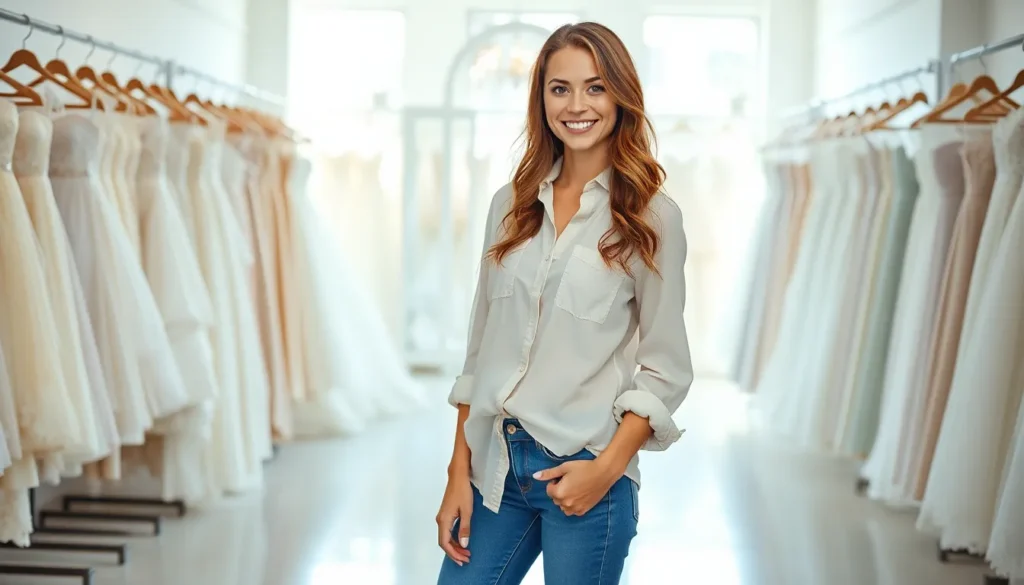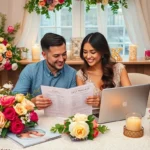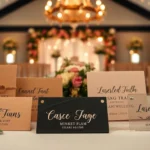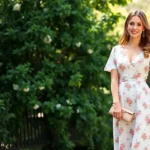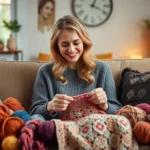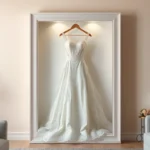Wedding dress shopping is one of the most exciting parts of wedding planning but choosing what to wear to your appointments can feel surprisingly overwhelming. We’ve all been there – standing in front of our closets wondering what’s appropriate for trying on the most important dress we’ll ever wear.
The right outfit can make or break your dress shopping experience. We need something that’s easy to slip on and off comfortable for hours of trying on gowns and flattering enough to help us envision ourselves as a bride. From the perfect undergarments to footwear that won’t leave us hobbling we’ll share insider tips that make dress shopping sessions smoother and more enjoyable.
Whether you’re hitting the bridal boutiques for the first time or you’re a seasoned dress shopper looking to refine your approach we’ve got you covered with practical outfit ideas that’ll help you focus on what really matters – finding your dream dress.
Choose Comfortable Yet Stylish Footwear for Long Shopping Days
Your feet will thank you for making smart footwear choices during wedding dress shopping adventures. We recommend selecting shoes that balance comfort with style since you’ll spend hours walking between boutiques and standing on fitting room platforms.
Opt for Low-Heeled Pumps or Wedges
Low-heeled pumps offer the perfect compromise between comfort and elegance during dress shopping sessions. We suggest choosing heels between 1-2 inches tall to maintain stability while still getting an accurate preview of your wedding day height. Block heels provide better weight distribution than stilettos and reduce foot fatigue throughout lengthy appointments.
Wedges deliver exceptional comfort for extended shopping trips since they distribute your weight evenly across the entire sole. The continuous heel design offers superior ankle support compared to traditional pumps while maintaining a sophisticated appearance. We recommend selecting wedges with cushioned insoles and breathable materials to keep your feet comfortable during multiple store visits.
Consider Supportive Flats with Arch Support
Supportive flats become essential for marathon dress shopping days that involve visiting multiple boutiques. We prioritize flats with built-in arch support and cushioned footbeds to prevent foot pain and maintain energy levels throughout the day. Quality flats with proper support allow you to focus entirely on finding your dream dress rather than managing discomfort.
Ballet flats with memory foam insoles provide cloud-like comfort while maintaining a polished appearance that complements any shopping outfit. Loafers with contoured footbeds offer professional styling with athletic-level comfort features. We recommend testing the flexibility of flat shoes by bending them gently – quality supportive flats should bend at the ball of the foot while maintaining their shape.
Avoid Brand New Shoes That Haven’t Been Broken In
Brand new shoes can create painful blisters and hot spots during extended shopping sessions. We strongly advise wearing shoes you’ve already broken in and know provide reliable comfort for several hours of walking and standing. Fresh-from-the-box footwear often requires adjustment time that your wedding dress shopping timeline simply doesn’t accommodate.
Breaking in shoes properly takes 3-5 wear sessions around your home before they’re ready for intensive shopping days. Stiff materials and rigid construction in new shoes can cause unexpected pressure points that develop into painful problems mid-appointment. We recommend choosing shoes you’ve worn successfully for at least 4-6 hours previously to ensure they won’t sabotage your dress shopping experience.
Select Undergarments That Mirror Your Wedding Day Foundation
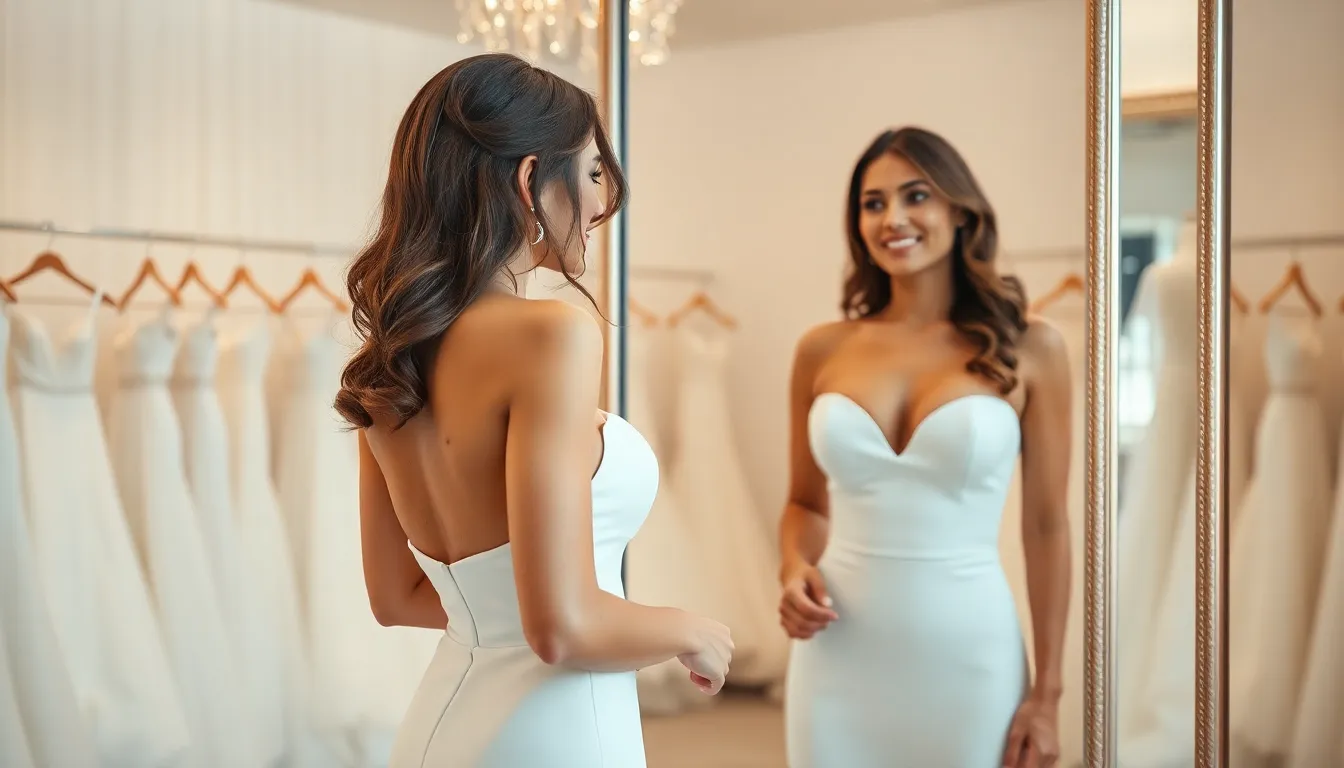
Your wedding dress foundation starts with the right undergarments, and we recommend bringing exactly what you’ll wear on your big day to get the most accurate fit during shopping sessions.
Wear a Strapless or Convertible Bra
Strapless bras offer the versatility you need when trying on various neckline styles during dress appointments. We suggest investing in a high-quality strapless bra that provides proper support without digging into your skin or sliding down. Convertible bras work exceptionally well since they transform from traditional straps to strapless, halter, or crisscross configurations based on your dress style.
Most wedding dresses feature strapless or off-shoulder designs, making a reliable strapless bra essential for accurate fitting. We find that brides who wear their planned undergarments during shopping appointments can better visualize their final wedding day silhouette.
Choose Seamless Undergarments to Avoid Lines
Seamless undergarments eliminate visible panty lines that can distract from a dress’s natural drape and beauty. We recommend selecting smooth, laser-cut styles that lay flat against your body without creating ridges or bumps under delicate fabrics like satin, silk, or crepe.
Visible lines can completely change how a dress photographs and appears in person, so seamless options become crucial for your shopping experience. We’ve found that even the most stunning gowns can look unflattering when worn over the wrong undergarments.
Bring Shapewear If You Plan to Wear It on Your Wedding Day
Shapewear changes your body’s silhouette significantly, so we strongly advise bringing your planned shapewear to every dress fitting appointment. Different levels of compression create varying fits in the same dress size, making it essential to try on gowns while wearing your intended foundation garments.
We recommend testing your shapewear comfort level during longer shopping sessions since wedding days involve extended periods of wearing these garments. Popular options include high-waisted briefs, bodysuits, and specialized bridal shapewear designed to work with strapless gowns.
Pick Clothing That’s Easy to Remove and Put Back On
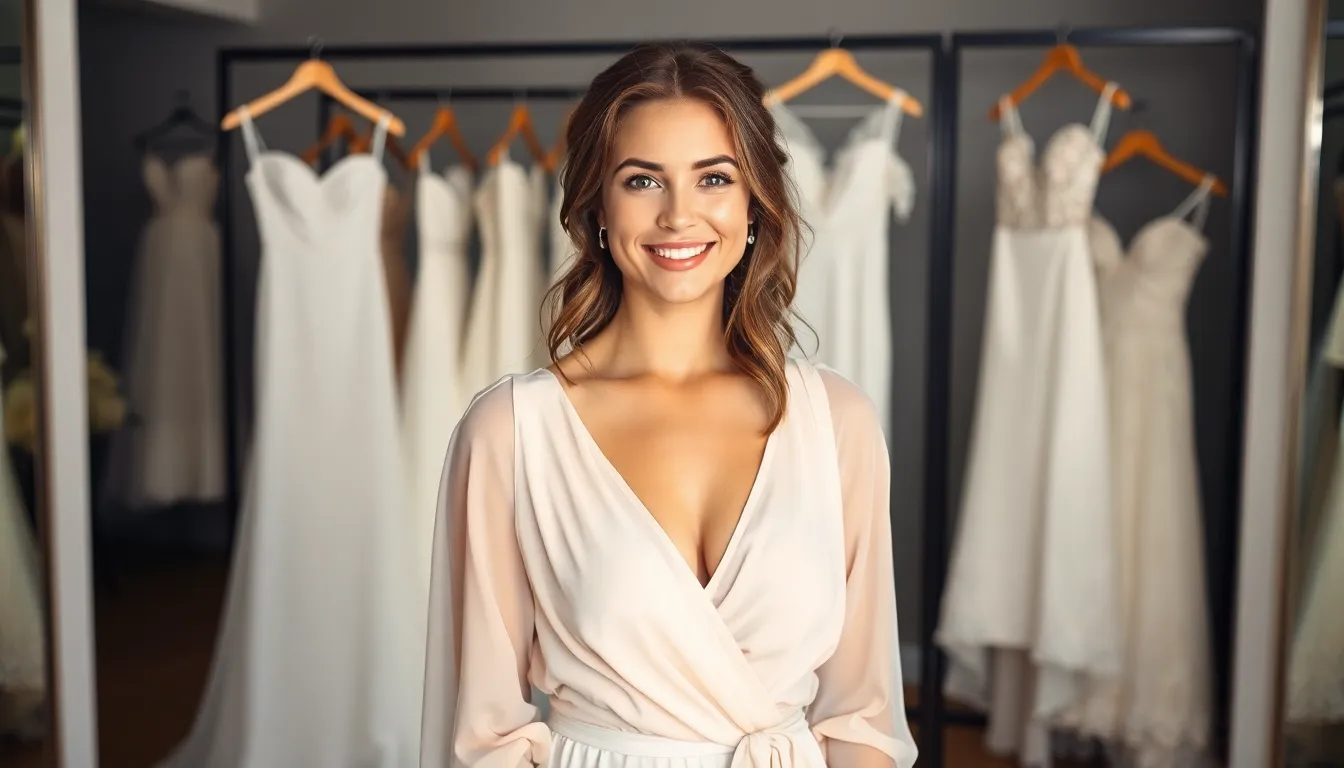
We recommend selecting garments that slip on and off effortlessly to streamline your wedding dress shopping experience. Quick outfit changes become essential when you’re trying on multiple gowns throughout the day.
Choose Button-Up Shirts or Wrap Tops
Button-up shirts offer the perfect solution for easy clothing removal without disturbing your carefully styled hair or makeup. We suggest opting for wrap tops as they eliminate the need to pull anything over your head during dress changes. These versatile pieces allow you to unbutton or unwrap quickly while maintaining your polished appearance throughout the appointment. Wrap styles particularly excel at protecting your hairstyle since they don’t require any overhead maneuvering.
Avoid Tight-Fitting or Complicated Clothing
Tight jeans create unnecessary struggles when you need to change quickly between dress fittings. We advise steering clear of restrictive bodysuits or complex garments with multiple layers that slow down the trying-on process. Complicated dresses featuring many zippers or buttons become cumbersome during long shopping appointments. Stretchy fabrics and casual dresses provide the comfort and flexibility you’ll need for extended periods of standing and changing. Comfortable materials ensure you can focus on evaluating each gown rather than dealing with wardrobe malfunctions.
Select Pieces Without Excessive Hardware or Embellishments
Minimal hardware prevents accidental damage to delicate wedding gowns during the fitting process. We recommend avoiding clothing with heavy buckles, sequins, or metal accents that could snag or stain precious dress samples. Excessive buttons, zippers, and snaps create unnecessary complications when assisting the bride with dress changes. Soft, neutral-colored clothing eliminates the risk of leaving marks on pristine gown fabrics. Simple, unembellished pieces allow you to move freely around the bride while helping her in and out of various dress styles without worry.
Dress in Neutral Colors to Avoid Color Distraction
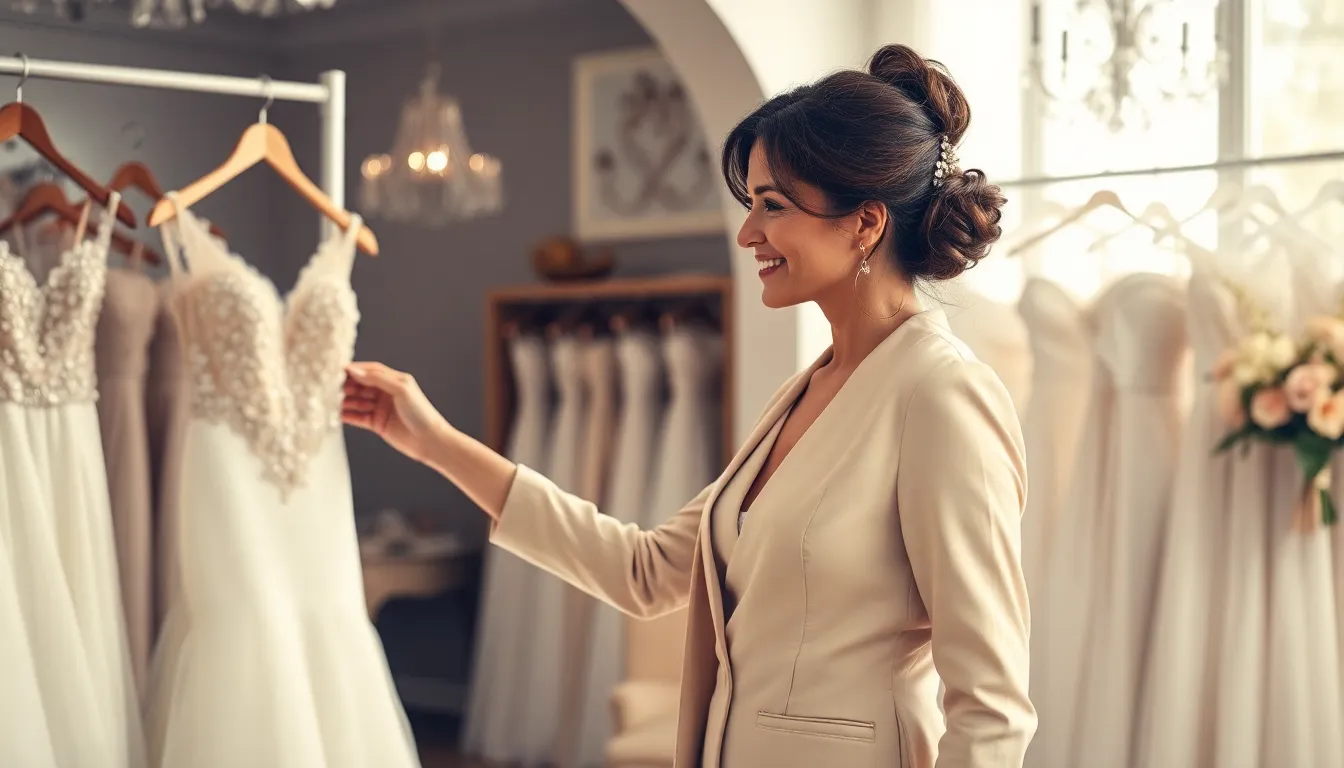
Color selection plays a crucial role in maintaining the proper atmosphere during wedding dress shopping appointments. We recommend choosing neutral tones that complement the bridal environment without competing for attention.
Stick to Black, White, Nude, or Beige Tones
Black offers timeless elegance while creating a sophisticated backdrop that makes bridal gowns appear more luminous. This classic choice works well with any wedding theme and helps us blend seamlessly into the bridal salon environment.
White can work beautifully when chosen carefully, though we suggest avoiding pure white or ivory shades that might compete with the bride’s gown. Cream or off-white tones provide a softer alternative that won’t clash with bridal fabrics.
Nude and beige create the perfect neutral foundation for wedding dress shopping sessions. These understated colors complement various skin tones while ensuring the bride remains the focal point throughout the appointment.
Neutral palettes blend effortlessly with different bridal salon atmospheres, from modern boutiques to traditional showrooms. We find these colors photograph well in group shots without drawing attention away from the bride’s special moment.
Avoid Bold Patterns or Bright Colors
Vibrant hues can create unwanted visual competition with the delicate details and fabrics of wedding gowns. Bright colors like electric blue, hot pink, or emerald green can overwhelm the subtle beauty of bridal designs.
Bold patterns draw the eye away from the bride and her dress selection process. Geometric prints, large florals, or animal prints can create visual chaos in photos and distract from the gown’s intricate details.
Color distraction affects the overall experience by shifting focus from the bride’s preferences to our outfit choices. We want to support the bride’s decision-making process rather than compete for attention.
Professional bridal consultants recommend keeping our color choices subdued to maintain the proper shopping atmosphere. This approach helps create a cohesive environment where the bride feels comfortable and confident.
Choose Solid Colors Over Busy Prints
Solid colors provide visual stability during wedding dress appointments, creating a calm backdrop that highlights the gown’s design elements. Simple, monochromatic pieces allow intricate bridal details to shine without competing patterns.
Busy prints can photograph poorly when we’re included in fitting room photos or group shots with the bride. Solid colors ensure we look polished and appropriate in any candid moments captured during the shopping experience.
Minimalist patterns work better than complex designs when we need to move around the fitting area or help with dress adjustments. Simple stripes or subtle textures provide visual interest without overwhelming the bridal environment.
Clean lines and solid fabrics demonstrate respect for the bride’s special day while maintaining our own sense of style. We can express personality through cut and silhouette rather than relying on bold patterns or distracting prints.
Layer Appropriately for Changing Room Temperatures
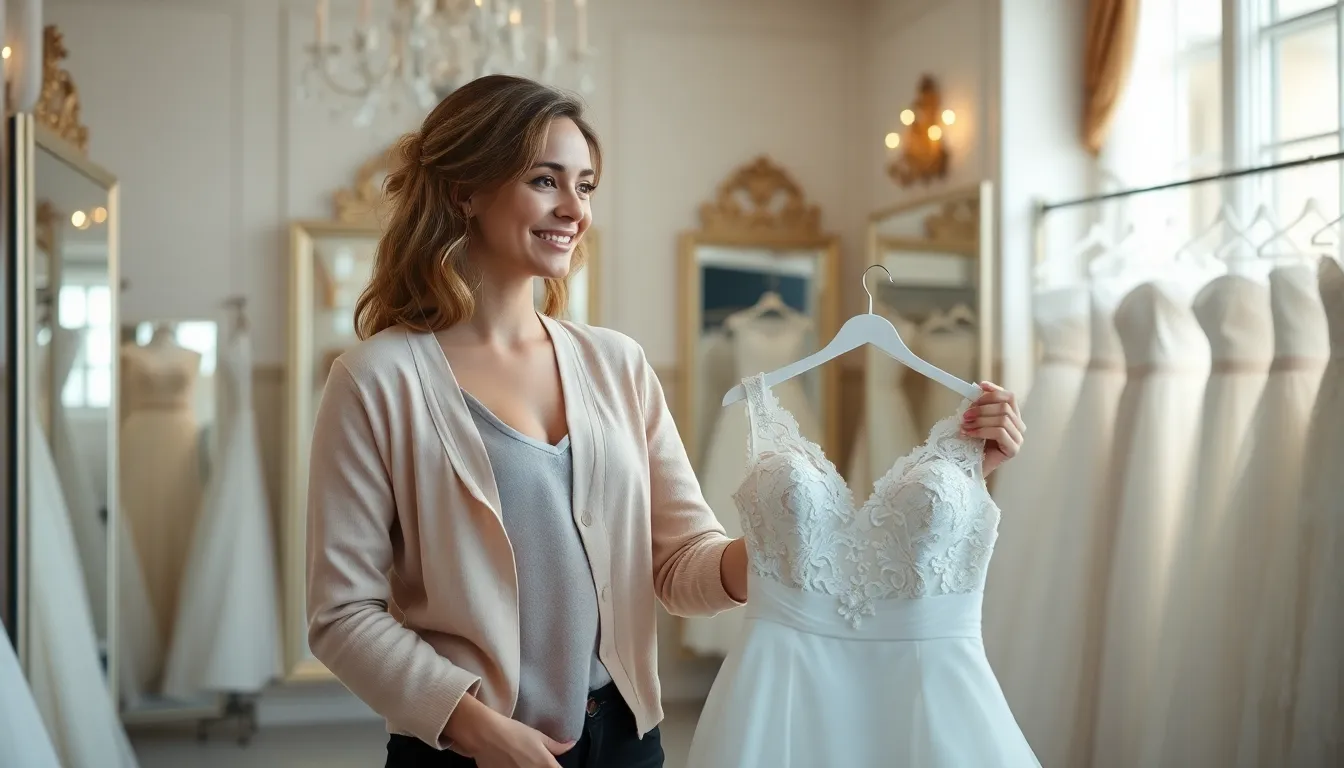
Bridal salons maintain varying temperatures in their fitting rooms, making layered clothing essential for wedding dress shopping comfort. We recommend strategic layering to adapt quickly to temperature fluctuations while maintaining easy access for dress fittings.
Bring a Light Cardigan or Blazer
Light cardigans provide warmth without bulk when fitting room temperatures drop unexpectedly. We suggest choosing thin knit cardigans in neutral colors like beige or cream that complement any wedding dress style you’ll try on.
Blazers offer structured coverage while maintaining a polished appearance throughout your appointment. Cotton blazers or lightweight wool blends work best since they won’t add unnecessary bulk under wedding gowns.
Remove layers quickly by selecting cardigans with simple button closures or open front styles. We find that wrap style cardigans and unstructured blazers allow for the fastest removal when consultants need to assess dress fit.
Maintain modesty while moving between fitting areas by keeping your cardigan or blazer nearby. This coverage proves especially helpful when walking through salon common areas between dress changes.
Wear Breathable Fabrics Like Cotton or Modal
Cotton fabrics regulate body temperature naturally, preventing overheating during extended shopping sessions. We recommend cotton blends for their moisture wicking properties and comfortable feel against skin.
Modal offers superior comfort with its silky smooth texture that won’t cling to wedding dress fabrics. This fabric’s breathability helps maintain comfort even when trying on multiple gowns in succession.
Avoid synthetic materials like polyester or nylon that trap heat and create uncomfortable shopping conditions. We’ve found these fabrics can cause excessive sweating, making dress removal difficult and uncomfortable.
Choose lightweight weaves in cotton or modal blends that provide coverage without weight. Ponte knits and jersey fabrics in these materials offer flexibility while maintaining their shape throughout your appointment.
Avoid Heavy Sweaters or Bulky Outerwear
Heavy sweaters create unnecessary bulk that interferes with proper dress fitting and assessment. We advise against thick cable knits or chunky sweaters that add volume under delicate wedding gown fabrics.
Bulky outerwear complicates fitting sessions by making dress removal and replacement time consuming. Puffy jackets, heavy coats, and oversized hoodies should stay in your car rather than entering the fitting room.
Thick fabrics distort dress silhouettes by creating artificial bulk that doesn’t represent your actual figure. We recommend leaving heavy winter coats and thick sweatshirts at home to ensure accurate dress fitting.
Streamlined clothing allows consultants to assess dress fit properly without fabric interference. Thin layers enable bridal stylists to see how wedding gowns drape naturally on your body shape.
Style Your Hair in Your Planned Wedding Hairstyle
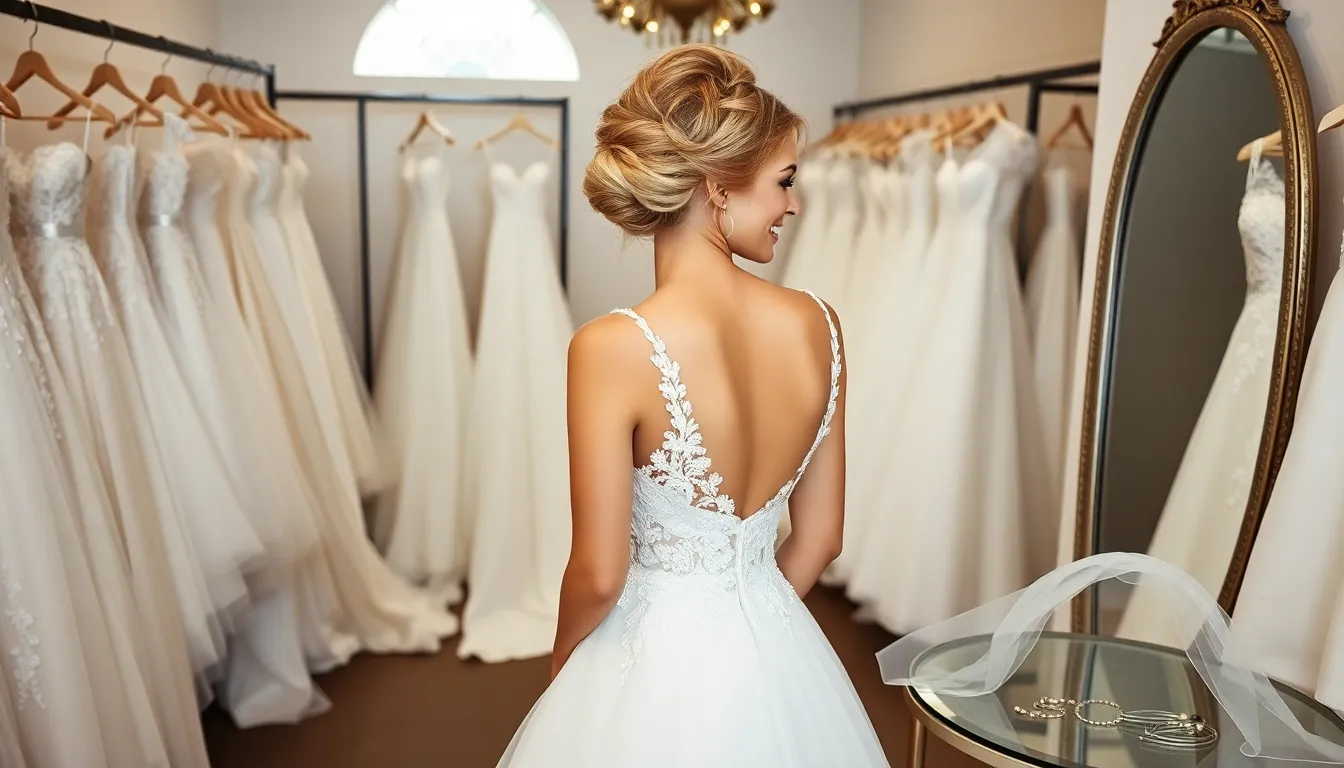
Creating your wedding day hairstyle during dress shopping appointments helps you visualize the complete bridal look. Styling your hair as you intend to wear it on your wedding day allows you to see how different necklines and dress styles complement your chosen hairstyle.
Practice Your Intended Updo or Down Style
Practice your wedding hairstyle in advance and arrive at your appointment with your hair styled accordingly. If you’re planning an updo, work with your hairstylist beforehand to perfect the look or practice creating it yourself at home. This preparation ensures you can accurately assess how various dress necklines will frame your face and complement your chosen style.
Plan to arrive with your hair already styled in your intended wedding look rather than hoping to visualize it later. An updo reveals more of your neckline and shoulders, making it easier to evaluate how strapless, off-shoulder, or high-neck gowns will appear on your wedding day. Down hairstyles create a different silhouette entirely, affecting how you’ll look in dresses with intricate back details or delicate straps.
Consider bringing photos of your planned hairstyle if you haven’t finalized the exact look yet. These visual references help bridal consultants understand your vision and provide better guidance on which dress styles will work best with your chosen hair direction.
Bring Hair Accessories If They’re Part of Your Vision
Bring along any hair accessories you plan to wear on your wedding day to see how they interact with different dress styles. Veils, headpieces, hairpins, and other decorative elements can significantly impact your overall bridal aesthetic and should be considered during the dress selection process.
Pack your veil if you’ve already chosen one, as it helps you understand how the dress and veil work together as a complete ensemble. Different veil lengths and styles complement various dress silhouettes, and seeing them together prevents any surprises on your wedding day.
Include any special headpieces, hair combs, or decorative pins in your shopping day kit. These accessories can influence which necklines and back details look most flattering, ensuring your entire bridal look feels cohesive and intentional.
Test how your hair accessories stay in place when you’re moving around in different dress styles. Some gowns require more bending or adjusting than others, and you’ll want to ensure your accessories remain secure throughout your wedding day activities.
Consider How Your Hair Will Look with Different Necklines
Evaluate how your planned hairstyle works with various neckline options during your appointment. An updo showcases statement necklaces and dramatic necklines beautifully, while down styles can soften bold neckline choices and create a more romantic feel.
Assess whether your hairstyle competes with or complements the dress details you’re considering. Intricate beadwork or lace details around the neckline may clash with elaborate hairstyles, while simpler dress designs can handle more dramatic hair choices.
Notice how different necklines affect the overall proportions of your look when combined with your chosen hairstyle. High necklines with updos can create an elegant, sophisticated appearance, while low necklines with flowing hair often produce a more bohemian or romantic vibe.
Ask your bridal consultant for feedback on how your hairstyle works with each dress you try on. Their experienced eye can spot combinations that work particularly well or identify potential styling conflicts you might not notice yourself.
Keep Jewelry Minimal and Wedding-Appropriate
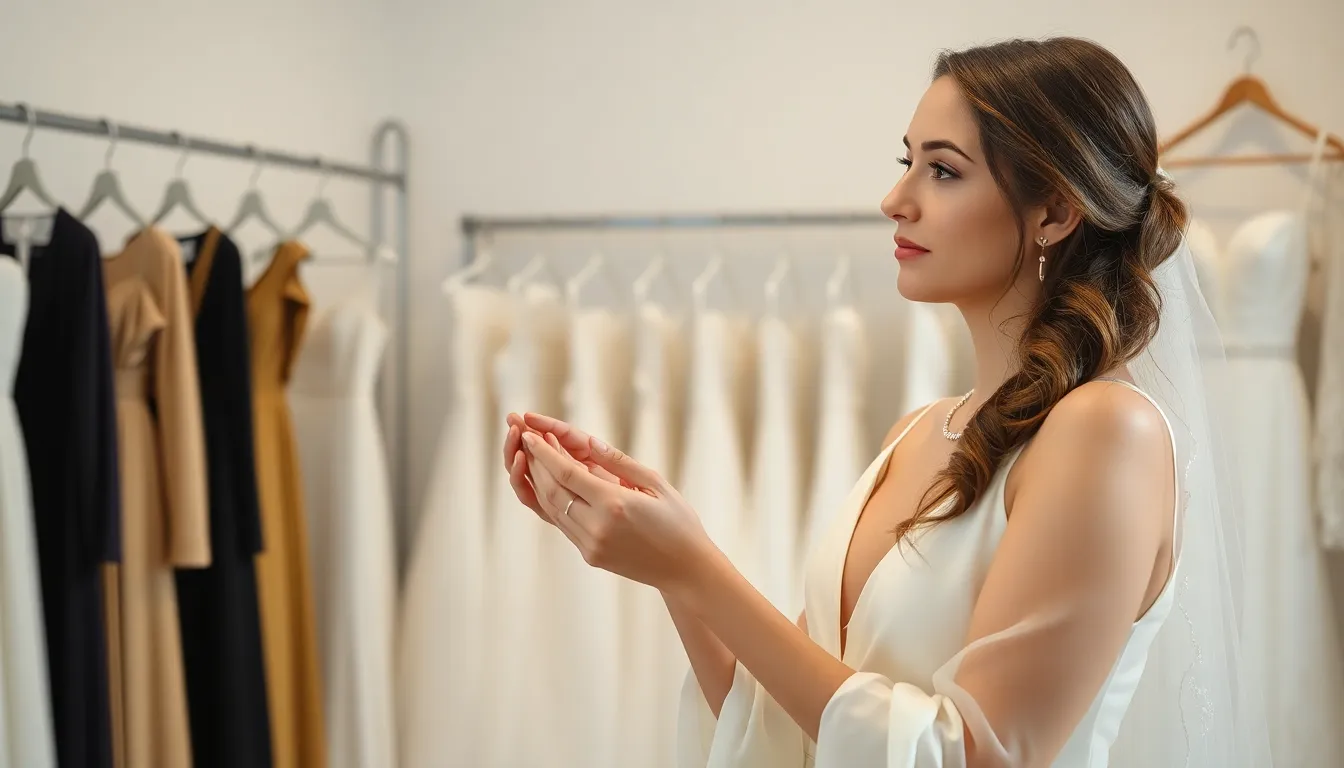
We recommend keeping your jewelry choices simple and understated to avoid snagging delicate wedding gown fabrics. Strategic accessory selection ensures you can handle dress materials safely while maintaining a polished appearance during your shopping appointments.
Wear Simple Stud Earrings
Simple stud earrings offer the perfect balance of elegance and practicality for wedding dress shopping sessions. We suggest choosing classic styles like pearl studs, small diamonds, or gold balls that won’t catch on delicate lace details or intricate beadwork. These earrings provide a polished look without creating visual competition with the bridal gowns you’re trying on.
Avoiding dangling or chandelier earrings prevents potential damage to wedding dress fabrics during the fitting process. We recommend testing how your chosen studs look with different neckline styles to ensure they complement various dress silhouettes. Small hoops can work as an alternative, but ensure they’re smooth and don’t have textured surfaces that might snag tulle or chiffon materials.
Choose Delicate Necklaces That Won’t Interfere
Delicate necklaces work best when they don’t compete with the wedding dress necklines you’re evaluating. We advise selecting thin chain necklaces or simple pendants that can easily be tucked away or removed when trying on gowns with intricate neckline details. These pieces allow you to maintain your personal style while ensuring the dress remains the focal point.
Avoiding statement necklaces or chunky chains prevents interference with strapless, off-shoulder, or sweetheart necklines during fittings. We recommend choosing pieces that sit close to your collarbone and won’t shift or move when you’re raising your arms or bending to examine dress details. Consider bringing a small jewelry pouch to safely store removed pieces between try-ons.
Remove Excessive Rings or Bracelets
Removing large rings and bulky bracelets protects delicate wedding dress fabrics from snags and tears during handling. We suggest keeping only your engagement ring and perhaps one simple band to minimize the risk of catching on lace appliques, beadwork, or embroidered details. This precaution becomes especially important when working with vintage gowns or dresses featuring intricate handwork.
Excessive jewelry on your hands can create unnecessary bulk when sliding into fitted sleeves or adjusting dress positioning. We recommend storing removed pieces in a secure location and considering how your final jewelry choices will work with your selected wedding dress style. Simple wedding bands or delicate tennis bracelets can remain if they’re smooth and won’t interfere with the fitting process.
Plan Your Makeup to Match Your Wedding Day Look
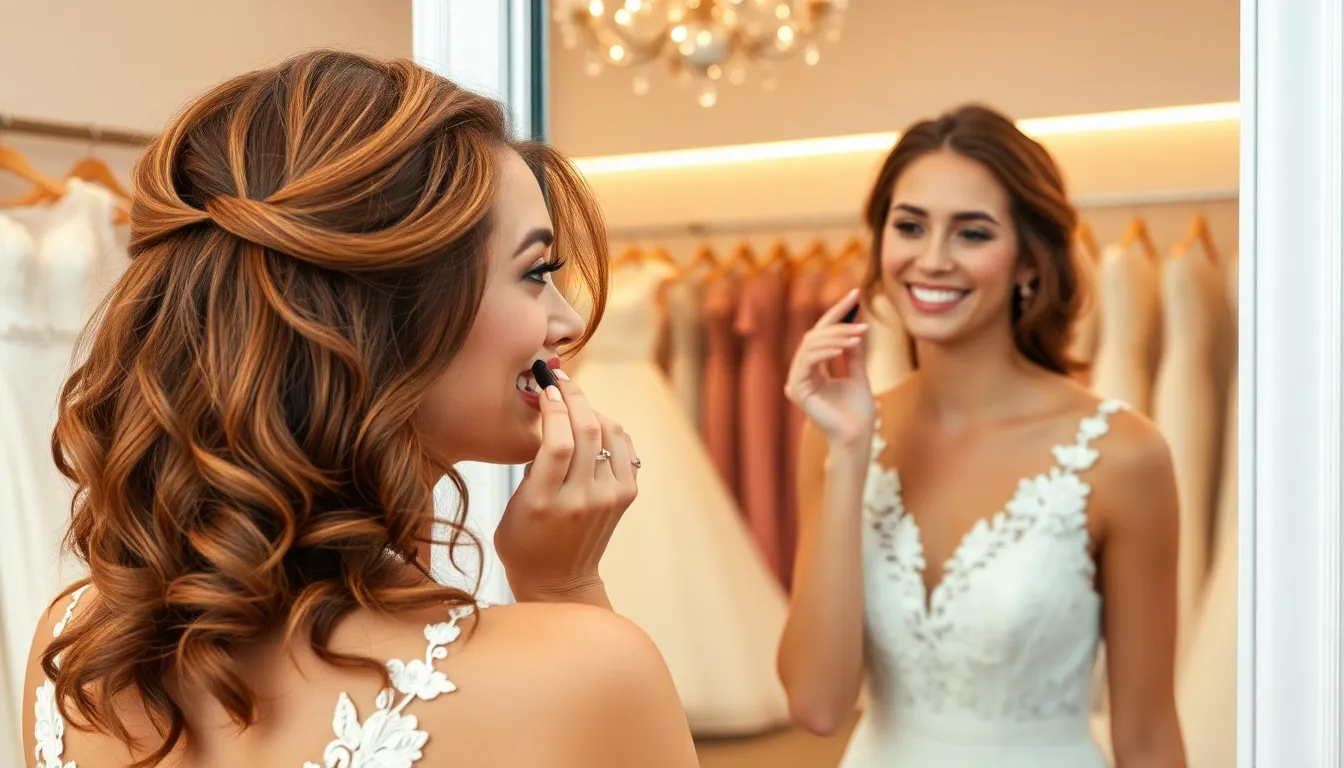
Testing your complete bridal look during dress shopping helps you envision how everything comes together on your special day. We recommend creating a makeup look that mirrors what you’ll wear for your wedding to get the full effect of each gown.
Apply Foundation and Concealer as Usual
Foundation creates the perfect base for your bridal look and helps you see how different dress styles complement your natural skin tone. We suggest using your everyday foundation routine to maintain a comfortable, familiar feel during your shopping appointment. Concealer should be applied to cover any blemishes or dark circles, ensuring your face looks polished and camera-ready.
Stick to products you know work well with your skin to avoid any unexpected reactions or breakouts before your big day. Your regular foundation and concealer combination will give you the most accurate representation of how you’ll look in wedding photos.
Keep Eye Makeup Natural and Photo-Ready
Natural eye makeup allows the focus to remain on the wedding dress while still making you look put together and polished. We recommend using neutral eyeshadow shades like soft browns, taupes, or champagne tones that complement various dress styles and colors. Mascara should be applied to define your lashes without creating dramatic volume that might distract from the gown’s details.
Photo-ready eye makeup means avoiding heavy eyeliner or bold eyeshadow colors that could clash with different dress styles. Simple techniques like lightly defining your brow bone and adding a subtle highlight to your inner corners will enhance your natural features without overwhelming the overall look.
Choose Lipstick That Photographs Well
Lipstick selection plays a crucial role in how your bridal look will appear in professional wedding photos and dress shopping pictures. We suggest choosing nude or soft pink shades that complement your natural lip color and won’t compete with the dress for attention. Matte or satin finishes photograph better than glossy formulas, which can create unwanted shine or reflection in photos.
Test your lipstick choice in different lighting conditions throughout your shopping appointment to ensure it looks flattering with various dress styles. Classic rose tones and berry shades tend to photograph beautifully and work well with most wedding dress colors, from pure white to ivory and champagne.
Bring Essential Accessories for the Appointment
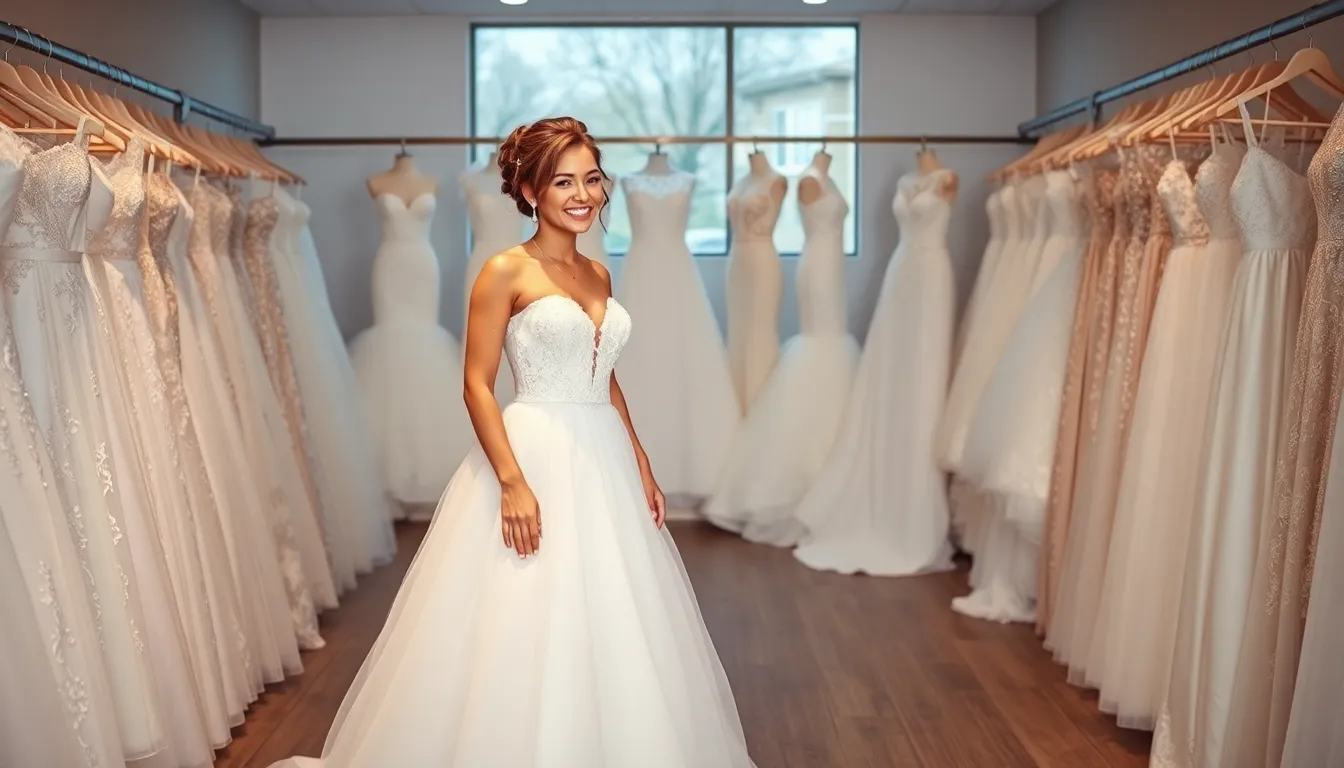
Strategic accessories can transform your wedding dress shopping experience from stressful to seamless. We’ve compiled the must-have items that’ll make your appointment more efficient and enjoyable.
Pack Comfortable Flip-Flops for Easy Dress Changes
Comfortable flip-flops should be your go-to footwear choice for wedding dress appointments. These slip-on shoes allow you to quickly change between gowns without struggling with laces, buckles, or complicated straps. Bridal consultants appreciate when brides wear shoes they can easily remove, as it speeds up the fitting process and prevents delays.
Ballet flats offer another excellent option for brides who prefer more coverage than flip-flops provide. We recommend choosing styles without ankle straps or complicated closures that might slow down dress changes. Your feet will thank you after hours of standing and walking around the salon.
Bring your actual wedding shoes if you’ve already purchased them. This allows you to see how each dress looks with your chosen heel height and ensures the hemming will be accurate. Many brides discover that certain dress styles look dramatically different when paired with their wedding footwear.
Bring Your Phone for Photos and Notes
Your smartphone becomes an invaluable tool during wedding dress shopping appointments. Taking photos of yourself in each dress helps you compare options later when details might become blurry in your memory. We suggest capturing multiple angles including front, side, and back views to get a complete picture of how each gown looks.
Create a notes app or document specifically for your dress shopping experience. Jot down the designer name, style number, price, and your initial impressions of each dress you try on. These notes become crucial when you’re comparing multiple dresses from different appointments or salons.
Ask your bridal consultant about their photo policy before snapping pictures. Most salons welcome photography as it helps brides make informed decisions, but some have exact guidelines about sharing images on social media before purchase.
Include Hair Ties and Bobby Pins
Hair ties and bobby pins are essential accessories that many brides forget to bring. These simple tools allow you to quickly pull your hair back when trying on different necklines and dress styles. Seeing how a strapless gown looks with your hair up versus down can significantly impact your decision.
Bobby pins help you temporarily secure your hair to test various wedding hairstyle options. You can create a quick updo to see how it complements a dress with intricate back details or beading. This visualization helps you understand how your complete bridal look will come together on your wedding day.
Different necklines require different hairstyle considerations, and having these accessories on hand lets you experiment freely. We recommend bringing several hair ties in case one breaks and enough bobby pins to create a secure temporary style that won’t fall apart during your appointment.
Consider the Season and Venue of Your Wedding

Weather conditions and venue formality directly influence what you should wear during your wedding dress shopping appointment. Aligning your outfit with these factors helps you better envision your complete bridal look.
Dress for Your Wedding Season’s Weather
Summer weddings call for light, breathable fabrics like cotton or linen during your dress shopping appointment. These materials keep you comfortable in warm boutique temperatures while allowing you to move freely between gowns. Sleeveless blouses and lightweight dresses work perfectly for hot weather appointments.
Winter shopping sessions require warm layers such as sweaters and boots to stay comfortable. Choose thin knit cardigans that provide warmth without adding bulk during fittings. Boot options should be easy to slip on and off, making dress changes more efficient throughout your appointment.
Spring and fall appointments benefit from versatile layering pieces that adapt to changing temperatures. Light jackets or blazers offer flexibility when boutique air conditioning varies between rooms. Breathable long-sleeved tops provide coverage while maintaining comfort during extended shopping sessions.
Match Formality Level to Your Venue
Formal venues require elevated dress shopping attire that mirrors your wedding day sophistication. Dress pants paired with stylish blouses create an appropriate level of formality for upscale venue brides. Professional-looking outfits help you visualize how formal gowns will complement your refined wedding setting.
Casual venues allow for more relaxed shopping outfits that reflect your laid-back wedding style. Comfortable casual dresses or well-fitted jeans with nice tops suit brides planning beach or garden celebrations. Relaxed attire helps you connect with bohemian or rustic dress styles during your appointment.
Traditional venues call for classic, timeless outfit choices that honor ceremonial expectations. Conservative dress options like knee-length skirts with modest tops align with church or historic venue requirements. Respectful attire ensures you can properly evaluate formal gowns within your venue’s context.
Think About Outdoor Versus Indoor Ceremony Requirements
Outdoor ceremonies demand practical footwear considerations during your dress shopping experience. Bring flat shoes or low wedges that mirror what you’ll wear for grass or sand venues. Testing dress lengths with appropriate outdoor footwear prevents last-minute hemming surprises.
Indoor venues offer more flexibility in shopping outfit choices and styling options. Heeled shoes work well for ballroom or hotel celebrations, allowing you to see proper dress proportions. Climate-controlled environments mean fewer layering concerns during your boutique visit.
Weather contingency planning affects both your shopping outfit and dress selection process. Bring layers or backup shoes if your outdoor venue requires weather-dependent footwear changes. Consider how wind, heat, or moisture might impact your chosen gown’s performance at your exact venue.
Conclusion
We’ve covered all the essential elements that’ll make your wedding dress shopping experience both comfortable and successful. From choosing the right undergarments and footwear to selecting neutral colors and easy-to-remove clothing these details truly matter when you’re trying on multiple gowns.
Remember that thoughtful preparation extends beyond just your outfit. Styling your hair as planned for your wedding day and keeping jewelry minimal will help you envision your complete bridal look. Don’t forget to consider your venue and season when putting together your shopping ensemble.
The goal is to create an environment where you can focus entirely on finding your dream dress without any distractions or discomfort. When you’re dressed appropriately for the occasion you’ll feel confident and prepared to make one of the most important style decisions of your life.
Frequently Asked Questions
What should I wear to my wedding dress shopping appointment?
Choose comfortable, easy-to-remove clothing in neutral colors like black, white, nude, or beige. Opt for button-up shirts or wrap tops that won’t mess up your hair when changing. Wear the same type of undergarments you plan to use on your wedding day, including a strapless or convertible bra and seamless underwear.
What shoes are best for wedding dress shopping?
Wear comfortable yet stylish footwear like low-heeled pumps, wedges, or supportive flats with arch support. Avoid brand new shoes that haven’t been broken in, as they can cause blisters during long shopping sessions. Choose shoes similar to what you’ll wear on your wedding day for accurate dress length assessment.
Should I wear shapewear to my dress fitting?
Yes, if you plan to wear shapewear on your wedding day, bring it to your fitting appointments. Shapewear can significantly alter how a dress fits and looks, so it’s essential to test it during fittings to ensure comfort and achieve the proper silhouette for your special day.
What undergarments do I need for wedding dress shopping?
Bring a strapless or convertible bra to accommodate various neckline styles, seamless underwear to avoid visible panty lines, and any shapewear you plan to wear on your wedding day. These undergarments should mirror exactly what you’ll wear during your wedding to ensure proper fit and appearance.
What colors should I avoid when dress shopping?
Avoid bold patterns, bright colors, and busy prints that can create visual competition with the bridal gown. Instead, stick to neutral tones like black, white, cream, nude, or beige. These colors provide a calm backdrop that allows the intricate details of the wedding dress to shine.
How should I style my hair for dress shopping appointments?
Style your hair exactly as you plan to wear it on your wedding day. This helps you visualize your complete bridal look and assess how different necklines complement your chosen hairstyle. Bring any hair accessories like veils or decorative pins to see how they work with various dress styles.
What jewelry should I wear to dress shopping?
Keep jewelry minimal and wedding-appropriate to avoid snagging delicate fabrics. Wear simple stud earrings like pearls or diamonds, delicate necklaces that won’t interfere with dress necklines, and remove excessive rings or bulky bracelets that could damage the gown during fittings.
Should I wear makeup to my dress appointment?
Yes, create a makeup look that mirrors what you’ll wear on your wedding day to visualize your complete bridal appearance. Use familiar foundation and concealer, opt for natural eye makeup, and select lipstick shades that photograph well, such as nude or soft pink tones.
What should I consider about the weather when dress shopping?
Dress according to the season and venue of your wedding. Choose light fabrics for summer appointments and warm layers for winter shopping. Consider versatile layering options for spring and fall, and plan for weather contingencies that might affect your wedding day outfit choices.
What clothing should I avoid wearing to dress shopping?
Avoid tight-fitting or complicated clothing like restrictive bodysuits or dresses with multiple zippers. Stay away from heavy sweaters, bulky outerwear, and garments with excessive hardware or embellishments that could damage delicate wedding gowns. Choose stretchy fabrics and simple silhouettes instead.

